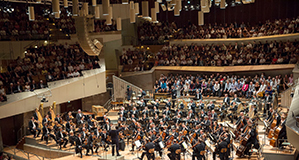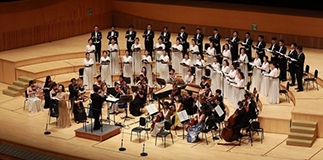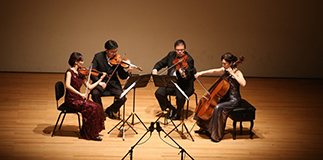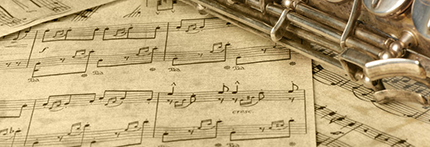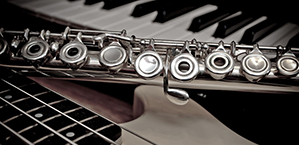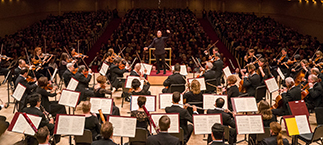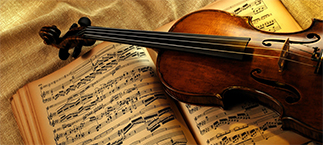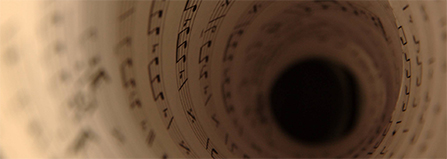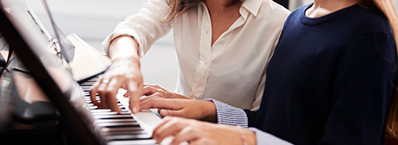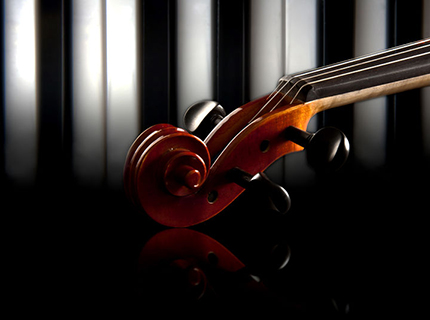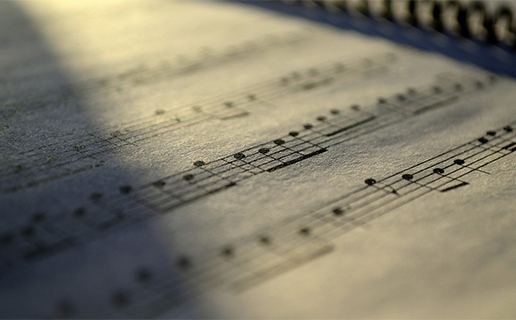从巴黎学院街传来的声音——旅法新锐钢琴家顾劼亭钢琴音乐会
Jean-Francois HEISSER &Jieting GU
Piano Concerto& Symphony Concert
钢琴/Piano: 顾劼亭/JietingGu
指挥/Conductor: 让-弗朗索瓦·海瑟 Jean-François HEISSER
乐团/Performer: 上海东方交响乐团/Shanghai Oriental Symphony Orchestra
乐团音乐总监/ Music Director: 许忠/XuZhong
曲目/Program:
贝多芬:降E大调第五钢琴协奏曲作品73号
Beethoven:Piano Concerto No.5 in E flat major, Op.73
中场休息/Intermission
圣桑:a小调第二交响曲作品55号
Saint-Saëns: Symphony No. 2 in a minor Op.55
拉威尔:G大调钢琴协奏曲
Ravel: Piano Concerto in G Major
时间/Time: 2013年12月15日19:30 / 7:30pm December 15, 2013
地点/Venue: 上海东方艺术中心音乐厅/Shanghai Oriental Art Center Concert Hall
时间/Time: 2013年12月21日19:45 / 7:45pm December 21, 2013
地点/Venue: 苏州文化艺术中心/Suzhou Culture and Arts Centre
音乐家的话
巴黎学院街——巴黎国立高等音乐学院
Conservatoire national superieur de musiqueet de danse de Paris
1795年8月3日,巴黎高等国立音乐学院在巴黎学院街成立。1991年12月7日迁至巴黎十九区的尚·饶勒斯街(Avenue Jeans-Jauré)。200多年以来,它已不仅仅是所名校,而是欧洲文化和西方音乐史的标签和骄傲。拉威尔、德彪西、圣桑、比才、柏辽兹、冼星海等等如雷贯耳的名字,都来自这儿。顾劼亭和他的导师让-弗朗索瓦·海瑟,将在丝绸之路的对岸向他们的前辈们致敬。
经典传承的脉络:
古典音乐(又称经典音乐)自古以来都是传承式发展,正所谓一脉相传,是指一个血统或派系世代相续流传下来。常比喻某种思想、学说或行为之间的继承关系。顾劼亭作为肖邦的第四代传人,带着最纯正的欧洲古典音乐血脉,将我们从现代拉回到两百年前的欧洲。
超越时空的东西方对话
东方或西方;古代或者近代;美,始终印刻在人们心中。东西方文化从来都不是对立的,艺术本身的乐趣和它的起源其实都是一样的——那就是人类对美的追求。顾劼亭将带大家一起超越时空,探索发现东西方文化的共鸣和宣泄。
流动的盛宴:
海明威在《流动的盛宴》中写到过“巴黎永远没有个完”等篇章,感悟“杂糅成一种对于巴黎的共同的历史记忆”。恰巧,这场音乐会也有这异曲同工之处。这是一场从东方流入西方,再由西方融回东方的音乐盛宴。作为盛宴的邀请者,顾劼亭试图用最流动的艺术方式——音乐:与被邀请者达到对古典一词的高度共识,感受瞬间既是永恒。
经典与现代的碰撞/物质与精神的融合
因为时代的发展需要我们大步向前走,但也却因此忽略了内心最本质的坚持。顾劼亭作为力求将古典钢琴与时尚、现代相融合的探索者与先驱者,重拾经典,带给这个社会的仿佛是一剂沁人心脾的强心剂。时代需要经典的声音,它不是被搁置了,只是需要有人去开启。

中国旅法新锐钢琴家:
顾劼亭 Jieting GU
顾劼亭,旅法青年钢琴演奏家。巴黎国立高等音乐学院钢琴最高演奏家文凭获得者,巴黎国立高等音乐学院首位华人钢琴硕士及室内乐硕士。
她3岁学习钢琴,6岁获得江苏省少儿钢琴比赛银奖,9岁考入上海音乐学院附小。18岁在导师——著名指挥家、钢琴家许忠先生的引荐下,赴法国巴黎深造。
2003年,顾劼亭师从法国当代最具影响力的钢琴教育泰斗Dominique Merlet教授。随后考入巴黎国立高等音乐学院,跟随著名钢琴家、指挥家 Jean-François Heisser教授学习。他们称赞她为“才华横溢的新一代中国钢琴家”。期间,她以优异成绩考入多个大师班,师从包括Jean Fassina、Jean-Claude Pennetier等钢琴大师。
她常年受邀于Animato,le printemps musical de saint-cosme,Moulin d’Ande,Academie Maurice Ravel等音乐节,演奏足迹遍布亚洲、欧洲及非洲。在巴黎科托音乐会、巴黎轻歌剧院、巴黎国际艺术城等众多重要音乐厅举办“24首肖邦钢琴前奏曲音乐会”,“阿尔贝尼兹钢琴作品音乐会”,“一个西班牙人在巴黎” ,“钢琴练习曲音乐会”等专场音乐会。她还热衷于慈善事业,2008年受法国安德尔-卢瓦尔省政府特邀,举办了“为了全世界的残疾儿童”公益音乐会。
2009年,在巴黎“德彪西专场音乐会”上,顾劼亭首次尝试将自己对中国传统文化艺术的独到见解,借助西方古典音乐的技法表现形式呈现给观众。她以一场听觉饕餮带领所有人沉醉在东西方文化的碰撞和交融之中。她独树一帜的演绎,在当时法国巴黎的音乐与艺术学术届引起了巨大的轰动,被多位艺术评论家誉为“黑白键上的丝绸之路使者”。
与此同时,她在室内乐演奏的才华也尽情展露,继成功组建了钢琴三重奏 “inspiration”之后,2010年,她又与瑞典青年大提琴家Hanne Dahlvist组成二重奏。他们错过了巴黎国立高等音乐学院的入学考试时间却因为精湛的技艺被学校全体评委一致通过破格录取。法国著名大提琴家Michel Strauss感叹为“近十年听到的最默契最精彩绝伦的重奏组合”。2010年,她获得法国拉威尔国际音乐节特别奖。2011年,她又斩获法国诺曼底国际室内乐比赛大奖。
2012年,顾劼亭回到国内,受邀成为上海东方交响乐团特邀驻团独奏钢琴家。
GuJieting is a pianist living in France with the diplomas of piano master in Conservatoire National Supérieur de la Music de Paris, chamber music master and Piano Supérieur Diploma.
Beginning piano study at three years old, she won a silver medal in Teens Piano Contest of Jiangsu Province at six years old and entered the primary school affiliated to Shanghai Conservatory of Music at the age of nine. When she grew to eighteen, she went to Paris for further study on the recommendation of ZhongXu, a famous conductor and pianist.
In 2003, GuJieting was taught by Professor Dominique Merlet, a leading authority with great influence in piano education in contemporary France. Then she entered Conservatoire National Supérieur de la Music de Paris and become a student of professor Jean Francois Heisser, a famous pianist and conductor. Teachers praised her as “a talented and brilliant Chinese pianist of new generation”. In the meantime, she was admitted by many master classes with excellent performances and was taught by piano masters such as Jean Fassina and Jean-Claude Pennetier.
She has been invited year in year out by many music festivals such as Animato, le Printemps Musical de Saint-cosme, la Musique de Moulin d’Ande, Academie Maurice Ravel and has been to Asia, Europe and Africa for performances. She held many concept concerts in various top music halls-Paris Cortot Concert Hall, Paris Opera Comique, Citéinternationale des arts Paris, for example, including “The Concert of 24 Chopin Piano Preludes”, “The Concert of Albeniz Piano Works”, “A Spaniard in France” and “Concert of Piano Etudes”. Moreover, she attached great attention to charity and held a public-oriented concert called “For Disabled Children around the World” at the special invitation of Indre-et-Loire government in 2008.
In 2009, GuJieting for the first time presented the audiences with her original views on Chinese traditional culture and art by means of western classical techniques at the “Concert of Debussy” in Paris. Everyone was lost in the cultural clashing and blending between the east and the west under her guidance to an auditory feast. Her unique performance caused a huge stir in Paris’ music and art field at that time and won her the title of “a silk road envoy on black and white keys” given by many art critics.
At the same time, her talent on chamber music fully unfolded. After successfully set up “Inspiration”, a piano trio, she formed a duet with a Swedish cellist Hanne Dahlvist. They missed the entrance competition of Conservatoire National Supérieur de la Music de Paris but the juries unanimously broke a rule to enroll them taking account of their excellent virtuosity. Michel Strauss, a distinguished French cellist, said that “it is the most fantastic duet with tacit cooperation in the past ten years”.
In 2010, she won a special award in AcadémieInternationale de Musique Maurice Ravel in France,. In 2011, she won an award in Normandy International Chamber Music Competition in France. In 2012, GuJieting returned home from abroad and accepted the invitation of becoming a pianist in Shanghai Oriental Symphonic Orchestra.
法国钢琴、指挥大师
让-弗朗索瓦·海瑟 Jean-François HEISSER
法国著名指挥家、钢琴家、教育家
让-弗朗索瓦·海瑟是可谓是当代古典乐坛重量级的全能大师。他出生于法国圣·艾蒂安,曾师从于20世纪钢琴大师瓦尔多·佩勒姆特(Vlado Perlemuter)等。
当代贝多芬的最佳诠释者
海瑟因为他的第一张系列专辑《保罗·杜卡斯钢琴作品》一炮而红,继而他又与由梅塔、雅诺夫斯基和赛格斯坦等指挥大师带领的一流乐团巡演多部梅西安作品。他录制的专辑包括阿尔贝尼斯、德彪西、圣桑等人的多部作品。后期海瑟演奏事业的重心一直放在对于贝多芬作品的阐释上,2000年Naïve公司出版了海瑟对贝多芬后期作品的录音,录音一经推出后受到媒体和听众一致好评,销量经久不衰。他与让-克劳德·卡萨德苏斯在阿姆斯特丹音乐厅、与普罗科菲耶夫在柏林歌剧院,法国喜歌剧院等地演奏了贝多芬全套协奏曲。除了演奏外,他还指挥波尔多·夏朗交响乐团对此套曲目举办了全球巡演。
立体的音乐家、古典音乐的先锋者
近年来,海瑟的独奏家和指挥事业并驾齐驱发展。作为艺术总监,他成功带领波尔多·夏朗交响乐团成为法国一流交响乐团。海瑟还是当代音乐的先锋探索者,他带领乐团首演了吉尔伯特·艾米的钢琴协奏曲,菲利普·马努里的 “未知的土地”,并由Praga公司录制出版。除了带领乐团与世界著名指挥家合作之外,他还经常和世界一流乐团如伦敦交响乐团、法国爱乐乐团、莫斯科爱乐乐团、法国国家交响乐团等。他还主导了法国巴亚那和贝桑松乐团2010-2011音乐季。同时,他是法国拉威尔音乐节艺术总监和阿尔勒音乐节艺术总监。
承上启下的音乐引航人
作为巴黎高等国立音乐学院的资深教授,海瑟培养了一批又一批杰出的青年钢琴家。他们当中很多都是当今乐坛的佼佼者,比如波特兰·沙马尤(Bertrand Chamayou)和简-弗兰德里克·纽伯格(Jean-Frédéric Neuburger)等。
"Artiste complet", l’expressionprend tout son sens avec Jean-François Heisser, pianiste, chef d’orchestre, pédagogue à la vaste culture et à la curiosité sans cesse en éveil.
Né à Saint-Etienne, titulaire de six premiers prix au Conservatoire de Paris, ilest le disciple et l’héritier de VladoPerlemuter et HenriettePuig-Roger avant de se perfectionnerauprès de Maria Curcio, récemmentdisparue. Il enseigne à son tour depuis 1991 au Conservatoire National Supérieur de Musique de Paris.Parmises disciples on peut citer Bertrand Chamayou et Jean-FrédéricNeuburger avec lesquelsilentretientune relation de grandecomplicité musicale.
Le début de son parcoursestpartagé entre la musique de chambre, uneactivitésoliste et la musiquecontemporaine :iljoue entre autres la Turangalilâ-Symphonie et Des Canyons aux Étoilesd’OlivierMessiaen avec les plus grandsorchestres sous la direction de Mehta, JanowskiouSegerstam. Ses premiers enregistrementsmarquants sont "l’œuvre pour piano" de Paul Dukas, le coffret "Espagne" (six CD chez Erato). Le filconducteur de sacarrièrerestetoutefois Beethoven, compositeurdontilenregistre les dernièresSonates, Bagatelles et Variations Diabelli (2 CD chez Naïve, 2000).
Depuis 2001, sacarrière a évoluéversuneactivitéconjuguée de soliste et de chef d’orchestre. Développant le projet de l’Orchestre Poitou-Charentes, "orchestre Mozart", ill’ahissé au plus haut niveau des formations françaises, ainsiqu’enattestel’enregistrement De Falla (L'AmourSorcier, Les Tréteaux de Maître Pierre, Mirare, 2007), salué par unepresseunanime.
Aucuneterra incognita ne découragel’insatiabledéfricheur au jugementaviséqu’estJean-FrançoisHeisser.C’estainsique le pianiste a récemmentcréé le Concerto de Gilbert Amy (Orchestrephilharmonique de Radio France), La Ville de Philippe Manoury (commande de Piano aux Jacobins enregistrée chez Praga), tandisque le pianiste et chef révélait, avec l'OPC, Terra Ignotade cecompositeur (Bouffes du Nord, 2008).
Son exigenced’interprète le pousse à jouerrégulièrementsur pianos historiques (Weber, les quatreSonates chez Praga, Konzertstück chez Mirare, sur piano Erard). Avec le chef François-Xavier Roth et son orchestre "Les Siècles", ilalterne claviers modernes (les troisConcertos de Bartók) et instruments d’époque (Saint-Saëns).
En 2009, iljoue Beethoven au Concertgebouw d’Amsterdam avec Jean-Claude Casadesus, Prokofiev à l’Opéra de Berlin, Saint-Saëns à l’OpéraComique de Paris et enfin les cinq concertos de Beethoven qu’ildirigera du piano avec l’OPC le 18 octobre. En parallèle, il a dirigédepuis 2008 les orchestres de Bordeaux, Île de France, Auvergne, Pays de Savoie, Colonne, Grenade. Il sera à la tête des orchestres de Bayonne et de Besançon au cours de la saison 2010-2011.
En avril 2010 est sortie une nouvelle version d’Iberiad’Albéniz (éditions Musicales ActesSud). Il a d’autre part enregistré un disque en hommage au pianiste Ricardo Viñes ; Debussy (avec HervéNiquet, Marie-Josèphe Jude et le chœur de la Radio Flamande) et le 4e Concerto de Saint-Saëns (live à l’OpéraComique avec François-Xavier Roth et "Les Siècles").
Il présideégalementl'Académie Maurice Ravel de Saint-Jean-de-Luz et assure la programmation des Soirées musicales d'Arles.
Aventuresetnouvellesaventuress’ouvrentdevant Jean-François Heisserdansl’espace-temps, maîtrisé, du monde musical.
著名钢琴家、指挥家——许忠
许忠是享誉国际乐坛的的最重要的中国钢琴家和指挥家之一,现任意大利贝里尼歌剧院艺术总监、首席指挥,以色列海法交响乐团的音乐总监、首席指挥,同时他也是上海东方交响乐团创始人、音乐总监。
许忠的杰出音乐成就得到了世界音乐界的广泛赞誉,他多次受聘于世界著名音乐学院,教授大师班,并在各大国际钢琴比赛担任评委。许忠指挥过的交响乐团包括:巴黎管弦合奏团、法国里尔国家交响乐团、戞纳交响乐团、意大利罗马交响乐团、西西里爱乐乐团、马西莫·贝里尼歌剧院管弦乐团、韩国KBS交响乐团、台北市立交响乐团、中国爱乐乐团、广州交响乐团、英国室内乐团、维也纳室内乐团、以色列室内乐团、以色列海法交响乐团等。2005年,许忠出任上海爱乐乐团执行艺术总监;2006年,组建上海东方交响乐团,并担任音乐总监和首席指挥至今;2009年10月出任韩国KBS交响乐团首席客席指挥;2010年年底,应意大利文化部邀请担任意大利国家音乐学院乐团首席指挥。2012年3月正式受邀担任意大利贝里尼剧院艺术总监和首席指挥,成为有史以来第一位出任意大利著名剧院该项职务的亚洲音乐家。2013年3月,许忠受邀出任以色列海法交响乐团音乐总监及首席指挥,同样也是以色列音乐史上首位担任乐团总监的中国艺术家。
许忠凭借一流的艺术表现力、鉴赏力和判断力,成为了一位优秀的艺术活动家,为繁荣艺术事业、促进中外艺术交流做出了重大贡献。2001年,创办了首届中国上海青年钢琴比赛,并任艺术总监,目前该比赛已经逐渐成为世界上最具活力和权威的钢琴比赛之一;2002年,任中国上海国际艺术节艺术顾问;2003-2005年,在中、法两国政府互办的中法文化年担任艺术顾问,并任“法国文化在上海”系列活动艺术总监;2004年,任上海东方艺术中心的艺术委员会委员;2005年,任上海大剧院艺术中心艺术委员会委员和上海音乐厅音乐顾问;2006年,任上海东方艺术中心艺术委员会副主席。
2010年,许忠荣膺由法国文化部颁发的法国文学艺术骑士勋章,用于表彰其在文化艺术领域对于中法交流的卓越贡献,由法国前总统德斯坦亲自为其颁发. 在受勋仪式上,德斯坦总统盛赞许忠先生一直以来不遗余力地在中国和世界范围内为推广法国音乐遗产所做出的贡献,并称其为“法国音乐遗产的最佳诠释者”。
As one of the most internationally renowned Chinese pianist and conductor in the world, XuZhong is Artistic Director and Chief Conductor of Teatro Massimo Bellini of Catania Italy, Music Director and Chief Conductor of Israel Haifa Symphony Orchestra and Shanghai Oriental Symphony Orchestra, Principal Guest Conductor of KBS Symphony Orchestra of Korea, and Executive Artistic Director of Shanghai Philharmonic Orchestra. He is also the founder of the China Shanghai International Piano Competition.
He has successfully collaborated with many of the most world-renowned musicians, including Paul Badura-Skoda, Lazar Berman, SergiuCommissiona, Philippe Entremont, NeemeJärvi, Maxim Vengerov, ArtoNoras, Jean - Bernard Pommier, Jian Wang, Marie-Pierre Langlamet and etc.
XuZhong was born in a family of well-known physicians for generations in the city of Shanghai. At the age of 17, he received the rigorous formal piano music education in the class of Dominique Merlet at Conservatoire National Supérieur de Musique de Paris. As a conductor, he learned with Prof.Xiaotong Huang, who is the leading professor of the most well-known Chinese conductors in the world. He also enjoys tremendously in artistic consultation with MarissJansons, Jean-Claude Casadesus and JormaPanula.
XuZhong won numerous prestigious international competitions since 1988, including the 1st Hamamatsu International Piano Competition, the Santander Paloma O'Shea International Piano Competition, the 5th Tokyo International Piano Competition and the 10th Tchaikovsky International Piano Competition in Moscow.
Since then, besides being the regular guest of Chinese orchestras and presenters, both as a pianist and conductor, he has taken up a concert career across Europe, North America, South America and South-East Asia. “La FolleJournée de Nantes au Japon” held in May 2006 reviewed him as a top artistic pianist bursting on to the world stage.
He represents the future of Asia. He has conducted Orchestre National de France, Orchestre National de Lille, Orchestre de Cannes, Ensemble Orchestral de Paris, Moscow State Symphony Orchestra, MDR Symphony Orchestra, Vancouver Symphony Orchestra, Orchestra Sinfonica di Roma, Orchestra dell'Arena di Verona, Orchestra dell'E.A.R. Teatro Massimo Bellini, Israel Haifa Symphony Orchestra, KBS Symphony Orchestra, Taipei Symphony Orchestra, China Philharmonic Orchestra, Shanghai Symphony Orchestra and Israel Camerata, Jerusalem and so on.
In capacity of jury member, Xu is regularly invited to attend the most worldwide important international piano competitions, such as Leeds, Clara Haskil, Busoni, Marguerite Long-Jacques Thibaud, Franz Liszt, AXA Dublin, Hamamatsu, Seoul, Sviatoslav Richter and Fryderyk Chopin.
XuZhong’s professional experience and achievements inside China are twofold: administrative and artistic. He has been Artistic Consultant of China Shanghai International Arts Festival and Artistic Director of “French Culture in Shanghai", L’Année de la France en Chine 2003/2005. He was nominated to be Music Consultant of Shanghai Concert Hall, member of Shanghai Grand Theatre Arts Group Artistic Committee and Vice President of Shanghai Oriental Art Centre Arts Committee.
In the coming season, XuZhong has been invited as guest conductor with Teatro del Maggio Musicale Fiorentino, Arena di Verona, Teatro Carlo Felice, Genova, Teatro di Verdi, Trieste, and for the opera production including Die Fledermaus, Pagliacci, CavalleriaRusticana, La Traviata, Orphee aux enfers, La Bohème and etc. Also, under the baton of XuZhong, Teatro Massimo Bellini will tour China in their first time and give Shanghai Oriental Art Center 2013-2014 Season two opening performances.
In 2010, XuZhong has been awarded the Chevalier de L’Ordre des Arts et des Lettres by the Ministry of Culture and Communication, France, for his contributions in classic music and cultural exchange.
上海东方交响乐团
上海东方交响乐团是中国大陆唯一股份制交响乐团,也是最具成长性、最具活力的交响乐团。乐团成立于2006年,由著名钢琴家、指挥家许忠先生独立创办并担任音乐总监、首席指挥,中国指挥界泰斗黄晓同先生担任艺术顾问。乐团自成立以来全面实行国际化市场运营机制,是演出曲目涵盖广泛、演奏风格细腻精致、演出形式灵活多样、海内外音乐精英荟萃的职业化交响乐团。
乐团致力于拉近古典音乐与普通大众间的距离,是上海东方艺术中心驻厅乐团、上海东方市民系列音乐会的指定乐团之一。乐团整合国际国内音乐资源,每年提前制定音乐季演出计划,并严格按照计划演出。乐团与国际接轨采取低成本运作模式,根据每一场演出曲目编制挑选乐手、聘请欧美外援音乐家作为独奏家、邀请国际指挥名家担任客座指挥,这样既充分保证了乐团演出水准也增进了国际文化交流。
从2006年至今,乐团已多次在欧洲、亚洲和国内进行巡演,演奏曲目从巴洛克时期到20世纪作曲家作品,充分展示了乐团对于从交响乐到室内乐不同类型曲目的驾驭力和控制力。
自成立以来,乐团每年举办音乐季演出和各类国际文化交流音乐会。2006年,乐团以纪念莫扎特诞辰250周年为主题,携手环球唱片公司Decca品牌联合推出了自己的首场音乐季演出;2007年,乐团为第四届中国上海国际钢琴比赛举行了开幕式演出,与五位世界著名钢琴大师合作贝多芬全套五首钢琴协奏曲;2008年,乐团在许忠率领下出访北欧,在芬兰纳坦利国际音乐节开幕式上举行演出,得到芬兰主流媒体的高度评价。许忠率乐团与王健成功合作于香港文化中心、成功制作歌剧《费加罗的婚礼》;2009年,乐团出访法国南特、波尔多等5个城市举行了7场音乐会。2010年乐团打造歌剧《灰姑娘》作为2010年上海世博会开幕庆祝演出隆重上演。12月,乐团推出马勒诞辰150周年纪念音乐会,成功演奏了《马勒G大调第四交响曲》;2011-12音乐季开幕音乐会上,乐团亚洲首演马勒的《吕克特歌谣》。2010年和2011年10月,乐团两度受邀在许忠带领下进行韩国巡演,访问首尔、大邱、全州、釜山多个城市并为釜山国际音乐节举行闭幕演出。
除了坚持推广古典音乐外,乐团还致力于多种样式与风格的音乐跨界合作。2008年,乐团与游戏运营商“第九城市”携手推出《魔兽世界视听·交响音乐会》;2010年,乐团分别与顶尖时尚品牌迪奥(Dior)和蒂凡尼(Tiffany)合作,相继在上海外滩和北京太庙举行演出,入列当年最受关注的时尚音乐盛事。
乐团锐意打造“文化精英”,通过整合国际资源,为旗下的音乐家们提供广阔的舞台,积极推动他们进一步成就个人艺术生涯。由此,常年担任声部首席的资深演奏家、在国际乐坛已享有一定声誉的海归人士、从音乐院校毕业的优秀学生等等一批当今中国乐界的精英人才汇聚于此。
一直以来,乐团与国内外知名音乐家和团体进行合作,其中包括著名指挥阿弗那·比隆;钢琴家皮耶托·帕莱契尼、中村紘子、米哈伊尔·鲁迪、弗拉基米尔·克莱涅夫、让·波尔纳·伯米耶;小提琴家雅赫·布雷;大提琴家王健和奥托·诺拉斯;竖琴家玛丽·皮埃尔-安拉美;黑管演奏家罗曼·吉奥;歌唱家简·康娜丽丝、席尔瓦·莫克拉、西蒙尼·皮亚佐拉;古典吉他演奏家杨雪霏等等。
东方交响乐团以国际化的经营模式与管理模式、国际音乐人才组合与能量聚集,为国内古典音乐界注入一股清新而强大的力量,从而加速推动交响乐在上海及中国的普及与发展,提升了上海在整个亚太地区乃至全世界的文化艺术地位。
Shanghai OrientalSymphony Orchestra
The Shanghai Oriental Symphony Orchestra is a professional orchestra developed from Shanghai Sinfonietta(founded in 2006) in the spirit of musical popularization and fosterage. As the resident ensemble of Shanghai Oriental Art Center located in Pudong New Area, it is committed to pushing the boundaries of musical art and to furthering the cause of symphonic music in China through professional training and career development.
Under the direction of Music Director XuZhong and the counsel of Artistic Consultant Huang Xiaotong, the Oriental Symphony Orchestra is established as an ‘Elite Orchestra’ consisting of some of the finest musicians in and out of China. By integrating international resources, the orchestra is able to provide specialized and professional training—in addition to numerous performance opportunities—for its musicians, which play a positive role in these individuals’ art careers. This platform attracts a great many Chinese and international music elites into the orchestra, among them being senior musicians, overseas world-renowned performers, top graduates from music colleges, etc. This dynamic combination of talents is sure to offer a new source of energy and innovation into the classical music world, in turn accelerating the popularization and development of symphony within Shanghai and helping to promote this international metropolis’ cultural status in the Asian-Pacific region, if not the entire world.
On October 10th, 2006, the orchestra started its first music season by concert performance, which not only marked the beginning of its national tour, but also served as a new-release ceremony of a record co-produced by Decca Music Group (Universal) and XuZhong to commemorate the 250th anniversary of Mozart’s birth.
During its music seasons, the Shanghai Oriental Symphony Orchestra has collaborated with an illustrious array of international and domestic musicians and groups, including Bruno Pasquier,Jian Wang, Xuefei Yang, ArtoNoras, Gérard Poulet,PiotrPaleczny,Hiroko Nakamura, Mikhail Rudy,Jean-Bernard Pommier, Vladimir Krainev,AvnerBiron, Trio Wanderer, etc. Since 2009, the orchestra has kicked-off annual opera productions, including Mozart <Le Nozze di Figaro> in 2009 and Rossini <La Cenerentola> as the opening ceremony of Shanghai EXPO 2010.
The Shanghai Oriental Symphony Orchestra has also been invited to perform in music festivals both at home and abroad, such as the Shanghai Spring International Music Festival, Shanghai International Art Festival, Naantali Music Festival (Finland) and the Busan Music Festival (Korea), to name a few. In June 2008, the orchestra was invited to hold Opening Series Concerts for the Naantali Music Festival. In July 2008, it helda concert tour in Hong Kong together with Jian Wang. In May 2009, it heldits first-evertour in France, consisting of 7 concerts in Nante, Angers, Saumur, Bergerac and Sérignan. In 2010 and 2011, it held Korea tours and was invited for the closing concert of Busan International Music Festival.
In addition to its many prior accolades, the Shanghai Oriental Symphony Orchestrais alsothe resident orchestra of the Shanghai Oriental Art Center.
曲目简介
Program
贝多芬:降E大调第五钢琴协奏曲 作品73号创作于1809年
Beethoven:Piano Concerto No.5 in E flat major, Op.73
I. Allegro 快板
II. Adagio unpocomosso 稍快的慢板
III. Rondo: Allegro 轮旋曲: 快板
路德维希·凡·贝多芬(Ludwig van Beethoven,1770—1827)德国著名的作曲家、钢琴家、指挥家,维也纳古典乐派代表人物之一。他一共创作了9首编号交响曲、35首钢琴奏鸣曲(其中后32首带有编号)、10部小提琴奏鸣曲、16首弦乐四重奏、1部歌剧、2部弥撒、1部清唱剧与3部康塔塔,另外还有大量室内乐、艺术歌曲、舞曲。这些作品对音乐发展有着深远影响,因此被尊称为乐圣。
降E大调第五钢琴协奏曲,本曲是德国作曲家贝多芬所有的钢琴协奏曲作品中,规模最为庞大的一部,故常被人称为“皇帝”协奏曲。而事实上,本曲也确实具有堂堂王者风范。但是“皇帝”这一标题并不是贝多芬自己命名的,也不可能和某一位特定的“皇帝”有关,公认的说法是由于本曲在当时被誉为无可争议的“协奏曲之王”,故此得名,并沿用至今。贝多芬自1808年开始着手创作此曲,并于第二年完成。在本曲中,作曲技巧炉火纯青的贝多芬,又设计出众多崭新的思路,整部作品在工整的结构中蕴含着壮阔的波澜、变化无穷的旋律,尤其以主奏钢琴的花奏开始的第一乐章,一开始便给听众以极其宏伟、华丽的印象。当时的音乐杂志《大众音乐报》曾这样评价本曲:“毫无疑问,这是所有已经创作出来的协奏曲中最富创造力、最富想象力和最引人注目的作品,同时也是在技巧上最为艰深的一部。
全曲共分三个乐章,其中第二、三乐章连续演奏:
第一乐章,快板,降E大调,4/4拍子,协奏风奏鸣曲式。主奏钢琴即以花奏方式弹奏出分解和弦,进而引出了管弦乐部分演奏的乐章主题,非常简洁而又华丽绚烂,此处可以看出贝多芬的作曲手法之精致。乐章经过高潮之后,在极强的兴奋状态中结束。
第二乐章,稍快一些的慢板,B大调,4/4拍子,自由的变奏曲式。和传统的钢琴协奏曲第二乐章一样,本乐章同为优美的徐缓乐章。乐章的主题似牧歌般悠扬、恬静,经过管弦乐部分对主题的充分演绎之后,主奏钢琴如编入万千光彩的绵绵音乐一般,持续奏出这一祈祷性的、淳净恬美的主题。
第三乐章,回旋曲,快板,降E大调,6/8拍子。在第二乐章逐渐减弱之时,主奏钢琴就开始反复轻轻提示出第三乐章的主题,突然主奏钢琴以爆发般地、无比猛烈的威力奏出辉煌的主题,标志着全曲进入了第三乐章。旋即由管弦乐对这一主题予以反复。主奏钢琴继而导出曲折的新主题,交响曲和协奏曲交相辉映,手法精致绝伦,充分反映出贝多芬超人的写作技巧。乐章结尾时速度再度转快,作最后冲刺的主奏钢琴猛然跃起,最后由管弦乐部分强而有力地结束全曲。
The Piano Concerto No. 5 in E-flat major, Op. 73, by Ludwig van Beethoven, popularly known as the Emperor Concerto, was his last piano concerto. It was written between 1809 and 1811 in Vienna, and was dedicated to Archduke Rudolf, Beethoven's patron and pupil. The first performance took place on 28 November 1811 at the Gewandhaus in Leipzig, the soloist being Friedrich Schneider. In 1812, Carl Czerny, another student of Beethoven's, gave the Vienna debut of this work.The epithet of Emperor for this concerto was not Beethoven's own but was coined by Johann Baptist Cramer, the English publisher of the concerto.[1] Its duration is approximately forty minutes.
The concerto is scored for a solo piano, two flutes, two oboes, two clarinets in B-flat (clarinet I playing clarinet in A in movement 2), two bassoons, two horns, two trumpets, timpani in E-flat and B-flat, and strings.
The concerto is divided into three movements:Allegro in E-flat majorAdagio un pocomosso in B majorRondo: Allegro ma non troppo in E-flat majorAs with Beethoven's other concertos from this time period, this work has a relatively long first movement. (At twenty-five minutes, the Violin Concerto has the longest; Piano Concerto Nos. 4 and 5 each have opening movements of about twenty minutes.)
Despite its use of simple chords, including a second theme constructed almost entirely out of tonic and dominant notes and chords, the first movement is full of complex thematic transformations. When the piano enters with the first theme, the expository material is repeated with variations, virtuoso figurations, and modified harmonies. The second theme enters in the unusual key of B minor before moving to B major and at last to the expected key of B-flat major several bars later.Following the opening flourish, the movement follows Beethoven's trademark three-theme sonata structure for a concerto. The orchestral exposition is a typical two-theme sonata exposition, but the second exposition with the piano has a triumphant virtuoso third theme at the end that belongs solely to the solo instrument. Beethoven does this in many of his concertos. The coda at the end of the movement is quite long, and, again typical of Beethoven, uses the open-ended first theme and gives it closure to create a satisfying conclusion.
The second movement in B major is, in standard contrast to the first, calm and reflective. It moves into the third movement without interruption when a lone bassoon note B drops a semitone to B-flat, the dominant note to the tonic key E-flat.
The final movement of the concerto is a seven-part rondo form (ABACABA), a typical concerto finale form. The piano begins the movement by playing its main theme, then followed by the full orchestra. The rondo's B-section begins with piano scales, before the orchestra again responds. The C-section is much longer, presenting the theme from the A-section in three different keys before the piano performs a cadenza. Rather than finishing with a strong entrance from the orchestra, however, the trill ending the cadenza dies away until the introductory theme reappears, played first by the piano and then the orchestra. In the last section, the theme undergoes variation before the concerto ends with a short cadenza and robust orchestral response.
圣桑:第二交响曲 作品号55 创作于1859年
Saint-Saëns:Symphony Nr.2 Op.55
Adagio marcato – Allegro appassionato
Adagio
Scherzo. Presto
IV:Prestissimo
夏尔·卡米尔·圣-桑(法语:Charles Camille Saint-Saëns,1835年10月9日-1921年12月16日)是一位属于浪漫时期的法国钢琴及管风琴演奏家,亦是一位多产的作曲家。他的作品对法国乐坛及后世带来深远的影响,重要的作品有《动物狂欢节》、《骷髅之舞》、《参孙与大利拉》等。 1859年圣桑发表第二交响曲,此曲时而舒缓,时而轻声低吟时而高亢雄壮,节奏欢快但不失紧凑。
Saint-Saens" redirects here. For the commune in Haute-Normandie, see Saint-Saëns, Seine-Maritime.Camille Saint-SaënsCharles-Camille Saint-Saëns (French pronunciation: [ʃaʁlkamijsɛ̃sɑ̃s]; 9 October 1835 – 16 December 1921) was a French composer, organist, conductor, and pianist of the Romantic era. He is known especially for The Carnival of the Animals, Danse macabre, Samson and Delilah (Opera), Piano Concerto No. 2, Cello Concerto No. 1, Havanaise, Introduction and Rondo Capriccioso, and his Symphony No. 3 (Organ Symphony).
At the age of sixteen, Saint-Saëns wrote his first symphony; his second, published as Symphony No. 1 in E-flat major, was performed in 1853 to the astonishment of many critics and fellow composers. Hector Berlioz, who also became a good friend, famously remarked, Il sait tout, maisilmanqued'inexpérience ("He knows everything, but lacks inexperience").
拉威尔:G大调钢琴协奏曲 创作于1929-1930年
Ravel: Piano Concerto in G Major
I. Allegramente 欢快的
II. Adagio assai 很慢的柔板
III. Presto 急板
莫里斯·拉威尔(MauriceRavel,1875-1937),法国作曲家,印象派作曲家的最杰出代表之一。“我一向将拉威尔看作是与拉莫和德彪西齐名的法国最伟大的音乐艺术家,是世界上伟大的音乐家之一。”——罗曼·罗兰
拉威尔G大调钢琴协奏曲创作于1929年至1931年间。这首协奏曲在很大程度上受到拉威尔曾在美国巡游时所听到的音乐会上爵士乐曲风的影响。该协奏曲被深深注入爵士和和声元素,在当时拉威尔钢琴巡演的巴黎以及美国广为流行着。Ravel说这首曲子他在精神上师法了Mozart及Saint-Saens等人的音乐,是一首明亮而轻鬆愉快的协奏曲。曾有人说,此曲就像一个上紧发条的玩具,一启动,便叽叽嘎嘎响个不停。想想,第一乐章开头以鞭子启动整个曲子,的确很有意思,好像是马戏团,一声鞭响,好戏上演,各种怪奇动物及特技表演出台。另外,有许多加入小鼓及小号的马戏气氛,也令人不禁想起Stravinsky在芭蕾舞乐Petrouchka中的一些片段。
全曲共分三个乐章:
第一乐章,活泼轻快地,传统的奏鸣曲式,明亮而华丽。乐章一开始由短笛奏出生动明快的第一主题。第二主题在E大调上奏出,旋律宽广动人。不久出现的新的主题中可以听到德彪西式的平行和弦和欢悦而有新意的情调。展开部以钢琴的爵士节奏为基础。尾声结合了第一主题的五声音阶的因素。在如列车飞驰的急速中,乐队与钢琴一起狂热地将第一乐章带至结束。
第二乐章,很慢的柔板。音乐极其淳朴、简洁、安宁,具有福雷音乐中的沉思,与第一乐章的喧闹欢快形成强烈的对比。拉威尔曾描述这部协奏曲是一首嬉游曲,并且在第二乐章中参考了莫扎特的《黑管五重奏》中的小广板乐章。起初时的钢琴独奏暗示了第一乐章出现过的主题。整个乐章中,钢琴左手单一的伴奏型节奏与右手优美的旋律并不十分相称,但显得与众不同,精心设计得不协和音造成的色彩令人想起作者的小提琴奏鸣曲。中间部分,在钢琴之后出现木管乐器有许多精彩的独奏片段。以两个调所呈现出的精美雅致的情调渐渐趋向热情,音乐再次安静下来时回到了原来的主题,这次由英国管优美地奏出,钢琴作音阶式的装饰。最后,钢琴以长长的颤音在弦乐的陪衬中结束——拉威尔在第一次与玛格丽特·隆谈及此曲时就已经确定了使用这样的颤音。
第三乐章,急板。在不到4分钟的短小篇幅中充满了激动人心的高难度技巧和强烈的节奏。音乐以几个生气勃勃的和弦开始,钢琴作托卡塔式的快速进行,黑管奏出爵士风格的旋律。新的主题又在钢琴上出现,圆号声部的表现与斯特拉文斯基的手法非常相似。钢琴以下行半音阶再次出现。在大管的一段絮叨之后,音乐逐渐激昂,最后,乐章在高潮中以与开始时相同的几个和弦干脆利落地结束。此乐章一气呵成,若不竖起耳朵聆听,恐怕会错过乐章中时时闪过的智慧和妙趣。
Maurice Ravel's Piano Concerto in G major was composed between 1929 and 1931. The concerto is in three movements and is heavily influenced by jazz, which Ravel had encountered on a concert tour of the United States.
The concerto was deeply infused with jazz idioms and harmonies, which, at the time, were highly popular in Paris as well as the United States, where Ravel was traveling on a piano tour. After his well-received tour, Ravel wanted to give the first public performance of this new work himself. However, health issues precluded this possibility, with his preparatory practice of Liszt's and Chopin's etudes leading to fatigue. He then planned a premiere for March 9, 1931, in Amsterdam, but these plans also were canceled due to his work on the Concerto for the Left Hand, his many public appearances, and his performances of his other works.[1]Eventually, Ravel offered the premiere and dedicated the concerto to Marguerite Long, who was known for her performances of the works of Fauré and Debussy and had earlier asked Ravel for a new work. She received the score on November 11, 1931, and played the concerto on January 14, 1932, with Ravel conducting the OrchestreLamoureux. A few days after this highly successful premiere, Ravel and Long started a tour of twenty cities in Europe, where the work was received with consistent enthusiasm.[1]The first North American performances were given simultaneously on April 22, 1932, by both the Boston Symphony Orchestra and the Philadelphia Orchestra at their home concert halls.
The work is scored for piano and an orchestra consisting of piccolo, flute, oboe, coranglais, E-flat clarinet, clarinet in B-flat and A, 2 bassoons, 2 horns in F, trumpet in C, trombone, timpani, triangle, snare drum, cymbals, bass drum, tamtam, wood block, whip, harp, 16 violins, 6 violas, 6 cellos, 4 double basses.
The first movement opens with a single whip-crack, and what follows can be described as a unique blend between the Basque and Spanish sounds of Ravel's youth and the newer jazz styles he had become so fond of. Like many other concerti, the opening movement is written in the standard sonata-allegro form, but with considerably more emphasis placed on the exposition.At 106 bars in length, the large exposition section contains most of the musical ideas presented in the first movement. After the opening whip-crack and snare drum roll, the piano is introduced, providing a methodical accompanying figure as the winds present the first subject. Soon, the piano stops and the orchestra roars to life with each section adding to the theme, eventually drifting into an eerie, dream-like statement from the piano. This soliloquy is short-lived as the orchestra reenters with a blues-influenced figure, shifting between major and minor modes. The second subject begins with an awkward dissonance (A♯ and B), but quickly establishes itself as a richly melodic section, reminiscent of Gershwin's Rhapsody in Blue.Following a quick chordal passage from the piano, the development begins, utilizing much of the material from the first subject. After progressing through a variety of modes, the music comes to a mystic section played by the harps and strings. Following a short rest, the section continues, but is quickly interrupted by a restatement of the "blues section" from the first subject.An abridged version of the first subject begins the recapitulation, after which a piano cadenza restates the second theme. Through this elaborate restatement, the movement progresses to an energetic coda and ends with a bawdy scale from the brass.
In stark contrast to the preceding movement, the second movement is a tranquil subject of Mozartian serenity written in ternary form. When Long praised the natural flow of the lengthy, seemingly effortless opening melody, Ravel responded: "That flowing phrase! How I worked over it bar by bar! It nearly killed me!”[1][3]The first theme is presented solely by the piano, the right hand playing the melody in triple meter (3/4) while the left hand accompanies in compound duple (6/8) with a rhythmically dislocated waltz that continues throughout the movement. After nearly three minutes, a C-sharp by solo flute breaks the spell of listening to a Chopin nocturne, whereupon oboe, clarinet and flute carry the melody into the second theme.This second theme is tenser than the first, utilizing dissonant harmonies and figures from the piano. Almost as easily as the theme appears, it fades away into a restatement of the first theme, this time played by the coranglais while accompanied by rustling ornamentations of the piano. A brief coda brings the movement to a gentle close.
The third movement recalls the intensity of the first with its quick melodies and difficult passage-work. Written in an abridged sonata form, the finale has been the subject of criticism since its premiere.The piano introduces the first subject, a rapid chordal figure, with dissonant interjections from the winds and brass. The subject continues with such interjections from all, and progresses through a multitude of modes before finally coming to its conclusion. Here, the movement ends with the same four chords with which it began.Possibly due to its short length, the third movement is often repeated by the orchestra and soloist as an 'encore' after the concerto.


